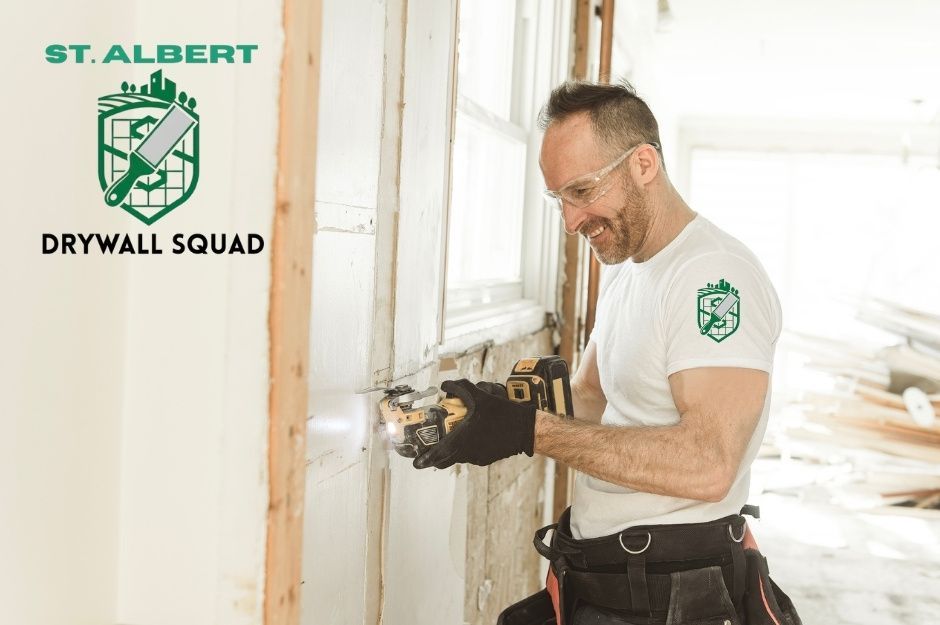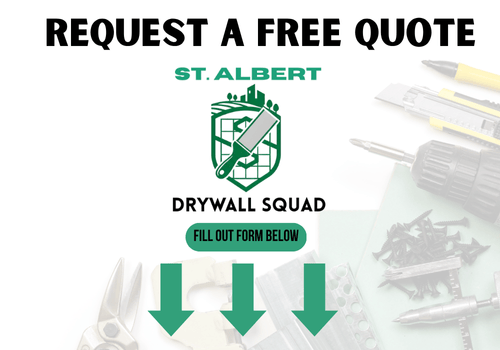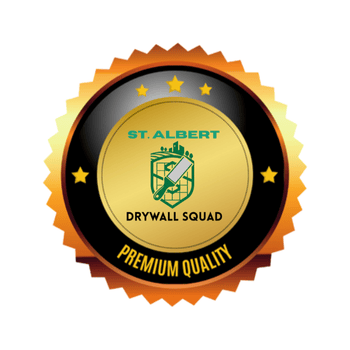Gibbons Drywall Repair
Professional Drywall Repair Company in Gibbons, Alberta

Homeowners in Gibbons, Alberta face various drywall challenges that require professional expertise to restore their walls and ceilings to pristine condition. Professional drywall repair contractors at St. Albert Drywall Squad in Gibbons offer specialized services including crack and hole repairs, nail pop fixes, water damage restoration, complete drywall installation, and expert finishing techniques like mudding and taping.

St. Albert Drywall Squad (CP)

Located just 37 km northeast of Edmonton along Highway 28A, this central Alberta town of approximately 3,600 residents experiences unique climate conditions that can affect drywall integrity throughout the year. Whether you're dealing with unsightly cracks, holes from furniture mishaps, water damage stains, or outdated popcorn ceilings, qualified drywall contractors in your area provide comprehensive solutions.
These skilled professionals handle everything from minor cosmetic repairs to major renovation projects that require hanging new drywall or installing soundproofing materials. Contractors serving Gibbons also extend their services to nearby communities including Bon Accord, Fort Saskatchewan, and the greater Sturgeon County region.
Your drywall repair needs don't have to compromise your home's appearance or structural integrity. Local contractors understand the specific challenges Alberta homes face and provide targeted solutions that address both surface-level imperfections and underlying issues to ensure lasting results.
Comprehensive Drywall Repair Services in Gibbons, Alberta
Professional drywall contractors in Gibbons address structural damage through crack patching, hole filling, hardware pop corrections, and moisture-related repairs. The town's proximity to the Sturgeon River and Alberta's temperature extremes—with winter lows reaching -30°C and summer highs exceeding 25°C—create seasonal expansion and contraction that particularly affects drywall structures. These services restore wall integrity and appearance using specialized materials and proven techniques.
Crack and Fracture Repairs
Wall crack repair requires identifying the underlying cause before applying fixes. Settlement cracks typically appear as hairline fractures along corners and ceiling joints.
Temperature fluctuations cause drywall to expand and contract, creating stress fractures. You'll notice these cracks widening during seasonal changes. In Gibbons, the dramatic temperature swings between winter and summer months make these seasonal cracks especially common in older homes built before modern building codes were implemented.
Common crack types include:
- Hairline cracks from settling
- Corner cracks at wall intersections
- Ceiling joint separations
- Tape joint failures
Contractors use mesh tape and compound for minor cracks. Larger fractures require removal of damaged sections and replacement with new drywall pieces.
Proper preparation involves cleaning loose material and priming the area. Multiple compound coats ensure smooth blending with existing wall surfaces.
Hole and Dent Restoration
Wall hole repair methods depend on damage size and location. Small nail holes need only spackling compound and sanding.
Medium holes require mesh patches or backing boards. Contractors cut patches slightly larger than the damaged area for secure adhesion.
Repair techniques by hole size:
- Under 1 inch: Spackling compound only
- 1-4 inches: Mesh patch with compound
- Over 4 inches: Drywall patch with tape and mud
Large holes need careful measuring and cutting of replacement pieces. The new drywall must match the existing thickness for proper alignment.
Dent repairs involve building up the depressed area with compound. Multiple thin coats prevent cracking and ensure durability. Sports equipment storage accidents are particularly common in Gibbons homes, where families with children involved in hockey, soccer, baseball, and lacrosse programs often need repairs from equipment-related wall damage.
Nail and Screw Pop Solutions
Nail pops occur when fasteners back out from framing lumber movement. You'll see small bumps or cracks around the protruding hardware.
Contractors hammer protruding nails back into place or replace them with screws. Additional fasteners near the original location prevent future pops.
The repair process involves:
- Securing loose fasteners
- Adding supplementary screws
- Applying compound over hardware heads
- Sanding smooth when dry
Screw pops happen less frequently than nail pops. When they occur, contractors typically add another screw nearby for reinforcement.
Proper compound application requires three coats: first coat fills the depression, second coat feathers edges, third coat provides final smoothing.
Water Damage and Stain Correction
Water damage creates stains, softening, and mold growth in drywall. You must address the moisture source before beginning repairs. Gibbons' location on the southern banks of the Sturgeon River means homes in low-lying areas may experience higher humidity levels and occasional flooding concerns, particularly during spring runoff when the Sturgeon River—a major tributary of the North Saskatchewan River—reaches peak flow.
Contractors assess damage extent by checking for soft spots and discoloration. Severely damaged sections require complete replacement to prevent mold.
Water damage indicators:
- Brown or yellow staining
- Soft or crumbling texture
- Musty odors
- Visible mold growth
Minor water stains need primer-sealer before painting. This prevents bleed-through of discoloration onto new paint layers.
Replacement involves cutting out damaged areas and installing new drywall. Proper ventilation during repairs prevents moisture buildup.
Contractors match existing wall texture during repairs. This includes orange peel, knockdown, or smooth finishes depending on your home's style.
Specialized Ceiling and Seam Repairs
Ceiling damage and seam failures require specific techniques and materials to achieve lasting repairs. These specialized services address structural issues that standard wall patching cannot properly fix.
Popcorn Ceiling Resurfacing
Popcorn ceiling removal and resurfacing involves scraping away the textured material and creating a smooth finish. This process requires careful preparation to contain debris and potential asbestos particles in older homes. Many homes in Gibbons were built during the 1970s and 1980s when popcorn ceilings were standard, making this a particularly common service request in the area.
Your contractor will first test the material for asbestos content before beginning work. If asbestos is present, specialized removal procedures must follow local regulations.
Resurfacing Steps:
- Plastic sheeting installation for containment
- Spray application of water to soften texture
- Manual scraping with specialized tools
- Drywall repair of any damaged areas underneath
- Primer application and new finish coating
The process typically takes 2-3 days for an average room. Your ceiling will have a modern, clean appearance that increases property value and eliminates dust collection issues common with textured surfaces.
Sagging Ceiling Restoration
Sagging ceilings indicate structural problems requiring immediate attention to prevent collapse. Drywall panels may separate from ceiling joists due to moisture damage, inadequate fastening, or building settlement.
Contractors assess the extent of damage using moisture meters and structural evaluation tools. Minor sagging may require additional fasteners and joint compound application.
Severe cases need complete panel replacement with proper attachment methods:
| Damage Level | Repair Method | Timeline |
|---|---|---|
| Minor sagging | Re-fastening and patching | 1 day |
| Moderate damage | Partial panel replacement | 2-3 days |
| Severe sagging | Complete ceiling rebuild | 4-7 days |
Your contractor will identify and address the root cause to prevent future sagging issues.
Seam Splitting and Tape Peeling
Seam failures occur when drywall joints separate due to building movement, temperature changes, or improper installation. Tape peeling creates visible lines and potential moisture entry points.
Professional seam repair involves removing failed tape and compound completely. Your contractor will clean the joint area and apply new mesh tape or paper tape with appropriate joint compound.
Repair Process:
- Remove loose tape and compound
- Sand joint area smooth
- Apply primer to bare drywall
- Install new tape with base coat
- Apply successive coats for seamless finish
Quality seam repairs require 3-4 days including drying time between coats. Proper technique prevents recurring failures and maintains wall integrity.
Professional Drywall Installation Solutions
Professional drywall contractors provide complete installation services for new construction and renovation projects. With Gibbons experiencing steady growth as a bedroom community for Edmonton commuters and families drawn to its excellent recreational facilities and Sturgeon School Division educational programs, new construction and renovation work remains consistently in demand. These services include proper hanging techniques and specialized soundproofing systems for various property types.
Drywall Hanging for Homes and Businesses
Professional drywall hanging requires precise measurement, cutting, and secure attachment to wall studs and ceiling joists. Contractors use specialized tools to ensure sheets are properly aligned and fastened at correct intervals.
The installation process begins with measuring your space and calculating material requirements. Contractors cut drywall sheets to fit around electrical outlets, switches, and fixtures before mounting.
Standard hanging specifications include:
- 16-inch stud spacing for residential walls
- 24-inch spacing for commercial applications
- Proper screw placement every 12 inches along edges
- 16-inch spacing in field areas
Commercial projects often require fire-rated drywall installation. These systems meet building code requirements for safety and structural integrity. Local businesses in Gibbons' downtown core and facilities like the Gibbons Arena, Gibbons Curling Club, Landing Trail Elementary, and Gibbons School often require commercial-grade drywall installation that meets Alberta Building Code standards.
Contractors handle both standard and moisture-resistant drywall for bathrooms and basements. They ensure proper gaps at floor lines and around penetrations for future finishing work.
Soundproofing and Acoustical Systems
Soundproof drywall installation involves specialized techniques and materials to reduce noise transmission between rooms. Contractors install multiple layers with sound-dampening compounds between sheets. Soundproofing is particularly popular in Gibbons homes where families want to reduce noise from home recreation rooms, especially given the community's strong sports culture with youth hockey, baseball, soccer, and lacrosse programs.
Common soundproofing methods include:
- Double-layer drywall with Green Glue compound
- Resilient channel installation
- Acoustic insulation in wall cavities
- Staggered stud construction
Sound ratings are measured in STC (Sound Transmission Class) values. Professional installation can achieve STC ratings between 45-60 depending on your specific requirements.
Contractors use thicker drywall sheets for enhanced sound reduction. They seal all gaps and penetrations with acoustic caulk to prevent sound leaks.
Commercial spaces often require specific acoustical performance standards. Professional installers ensure compliance with local building codes and project specifications. The Gibbons Curling Club's renovated lounge and the arena facilities benefit from proper acoustical treatments to ensure comfortable environments for spectators and players alike.
Quality Drywall Finishing Techniques
Professional drywall finishing requires precise mudding techniques to create seamless surfaces and expert taping methods to eliminate visible joints. These skills ensure your walls achieve a smooth, paint-ready finish that meets industry standards.
Mudding and Smoothing Surfaces
Mudding involves applying joint compound in multiple coats to create perfectly smooth drywall surfaces. Professional contractors use a three-coat system for optimal results.
The first coat embeds tape and fills the deepest areas of joints and fastener holes. This base coat covers approximately 6 inches wide and doesn't need perfect smoothness.
Your second coat extends 8-10 inches wide, feathering the edges to blend with the surrounding drywall surface. This coat builds thickness and begins the smoothing process.
The final coat spans 12-16 inches wide, creating seamless transitions. Contractors sand between coats using fine-grit sandpaper to remove ridges and imperfections.
Key mudding tools include:
- 6-inch, 10-inch, and 12-inch knives
- Corner trowels for inside angles
- Pole sanders for ceiling work
Temperature and humidity affect drying times significantly. Proper conditions ensure each coat cures completely before applying the next layer. Alberta's dry climate generally provides favorable conditions for drywall compound curing, though contractors in Gibbons must account for extreme winter cold that can extend drying times and summer heat that may cause too-rapid drying.
Expert Taping and Joint Treatments
Taping creates strong, invisible joints between drywall sheets using paper or fiberglass mesh tape. Paper tape works best for flat joints, while mesh tape suits corners and repairs.
Professional contractors embed tape completely in the first mud coat, eliminating air bubbles and wrinkles. Proper embedding prevents tape from showing through subsequent coats.
Inside corners require specialized techniques:
- Fold paper tape along the crease
- Apply compound to both walls simultaneously
- Use corner knives to achieve sharp, straight lines
Outside corners use metal or plastic corner beads for durability and clean edges. These beads attach with nails or adhesive before mudding begins.
Butt joints between drywall sheets need extra attention due to their thickness. Contractors often apply a thin skim coat across the entire joint area to prevent shadowing under paint.
Quality taping eliminates ridges, bumps, and visible seams that compromise your finished wall appearance. Experienced contractors serving Gibbons and the surrounding Sturgeon County area ensure finishes meet the high standards expected by homeowners in this growing, family-oriented community.